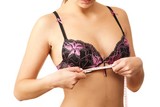A Bra That Fits: Finding Your Perfect Size
 If you’ve went up or down in weight, had a baby, weaned a child, or even gone through menopause, there’s a good chance your breasts have changed in shape and size. Supporting your current bustline with a comfortable bra is essential, when you consider a bad bra can cause chronic upper back, neck, and shoulder pain, and even skin abrasions. A bad bra can also make your breasts look just plain strange under clothing.
If you’ve went up or down in weight, had a baby, weaned a child, or even gone through menopause, there’s a good chance your breasts have changed in shape and size. Supporting your current bustline with a comfortable bra is essential, when you consider a bad bra can cause chronic upper back, neck, and shoulder pain, and even skin abrasions. A bad bra can also make your breasts look just plain strange under clothing.
True, finding a brassiere that fits may seem an impossible task. But a perfectly-sized garment is possible. Really!
Here’s a classic formula for finding your best fit:
* Use a measuring tape–the kind found in a sewing kit, not the type buried in a tool box.
* Enlist help. Your measurements will be more accurate if someone else takes them. If that’s not possible, begin by facing a full length mirror.
* Measuring against bare skin will give you the most accurate results. If someone else is taking your numbers and you’re feeling shy, don a tight-fitting seamless T-shirt over bare breasts.
* There are two elements to your bra size; the band size (i.e. 32, 34, 36) and cup size (ie. A, B, C). Start with band size, also called frame size: Wrap the measuring tape tightly around your rib cage, just below your bust. Add 5 inches to the measurement. Thus, a rib cage measurement of 27″ + 5″ would equal a 32″ band size.
* Find your cup size: Measure loosely around the fullest part of your bust. Subtract your band size from this measurement. A difference of 1″=A cup, 2″=B cup, 3″=C cup, 4″=D cup. For example, a cup measurement of 34″ – 32″ band size equals 2″, or a B cup.
* Be prepared to re-measure every few years. Breasts change size with time, which is why bra-fitting experts recommend re-evaluating your measurements at least once every two years–more often if you’ve lost or gained a significant amount of weight or had a baby.
How is a Bra Supposed to Fit
Knowing your bra size is important, but so is knowing exactly how a bra is supposed to fit.
* Cups: The cups should be filled out so they fit smoothly. If there are wrinkles, you may need a smaller cup size. In the case of cotton/spandex underwire bras, there should be a little excess fabric in the cups to allow for shrinkage. If there is overflow at the top, under the arms, you should try a larger cup size.
* Security. Your breasts should be held snugly in place, even when you lift your arms, bend over, run or jump.
* Band: The band should be fitted, but not cutting into your skin. It should sit lower on the back than in the front and sit comfortably below the shoulder blades. The back of the bra should not ride up above the bra line. If it does, adjust the straps. If the bra still rides up, try a smaller band size.
* Bra Straps: Straps should be adjusted to give support to the bust without cutting into the shoulders. If the straps are falling down, you may not be filling up the cups. Try a smaller cup size.
* Underwires: All pressure should lie on the underwires to support the breasts without digging in at the sides. Underwires lie flat against the chest. If the underwire is standing away from the body, experiment with a bigger cup size. Underwires should completely surround the breast tissue to provide support.
* The center piece–and underwire, if the bra has it–should lay flat against your chest. It should not shimmy up onto breast tissue or dig into your skin. So should the underwire, if the bra has it.
Common bra fitting problems – and solutions:
* The band in back rides up. Any one of three tricks may work: If possible try fastening the hook on a tighter enclosure, go down one band size, or loosen your bra’s shoulder straps.
* Loose or wrinkled cups. Go down one cup size.
* Breasts spill out of cups. Try a larger cup size or choose a bra style that offers more coverage through the cups.
*Red strap marks. Try loosening the bra’s straps. If that doesn’t work, you can pad your bra’s straps or try a more breast-supportive bra, one that doesn’t require the shoulder straps to do all the uplifting.
* Falling straps. Try tightening the straps. If you have a problem with perpetual falling straps, you may want to try a different style of bra, such as a T-back, U-back or racerback style.
* One of your breasts is bigger than the other. (Note: If this is you, relax. Most women are a bit assymetrical.) Fit the cup to the larger breast, then tighten the strap a bit on the smaller side to compensate. Or, have your bras custom-made.
* Large-busted? Go with an underwire, full-coverage bra, which are made to completely cover the breast . Not only are full-coverage styles more comfortable for the full-figured, they are more flattering. Look also for wide straps, which are less likely to dig into skin.
*Small-busted? If you’d like to look bustier, try a padded bra, a cleavage-enhancing bra or a demi bra which can lift breasts and enhance cleavage.
Stephanie Pedersen is a journalist who writes about health, food, beauty and fashion. She is currently working on a book about shoes and is the author of The Bra: A Thousand Years of Style, Support and Seduction (David & Charles Publishers), KISS Guide to Weddings and Kiss Guide to Beauty (both published by DK Publishing).

